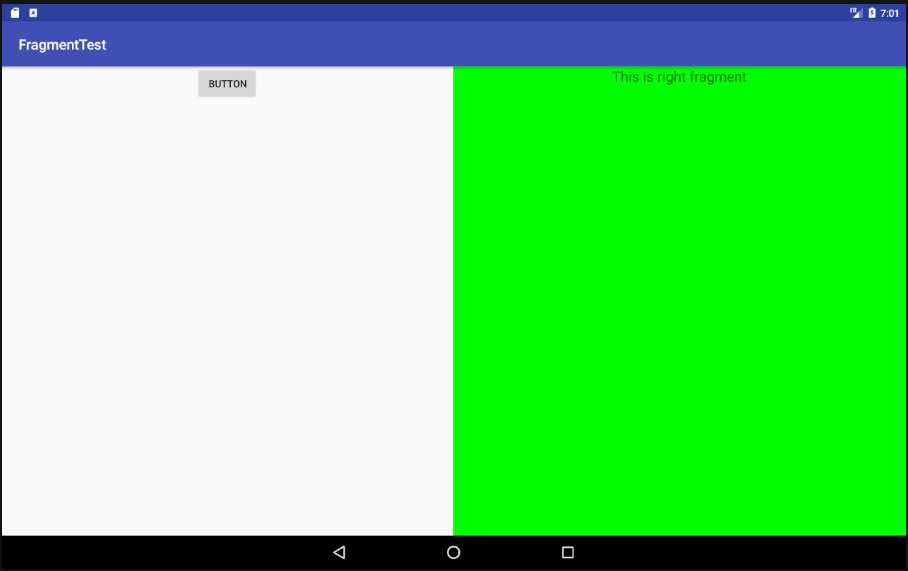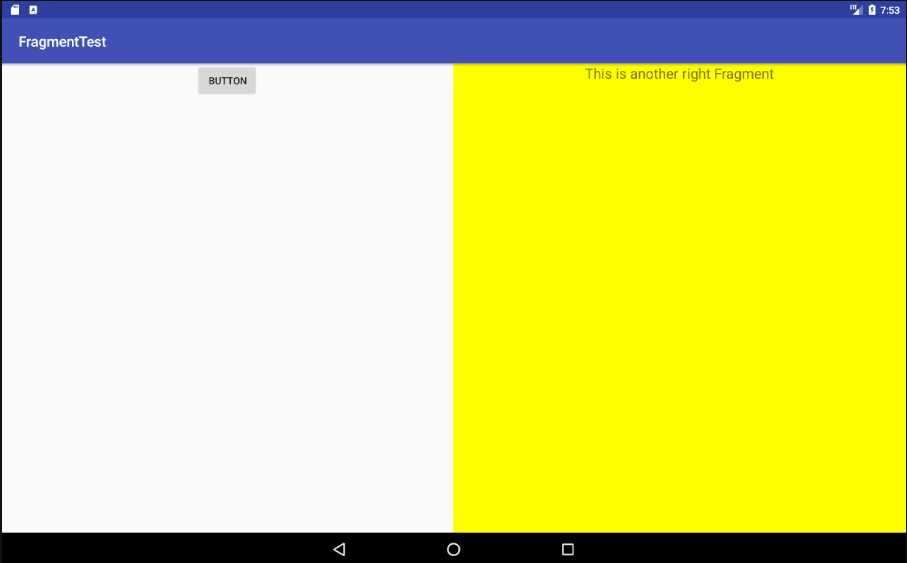<Android基礎>(四) Fragment Part 1
Fragment
1)Fragment的簡單用法
2)動態添加Fragment
3)在Fragment中模擬返回棧
4)Fragment和活動之間通信
第四章 Fragment
Fragment是一種可以嵌入在活動當中的UI片段,它能讓程序更加合理和充分的利用大屏幕的空間,比如橫屏和平板。
4.2 Fragment的使用方式
創建一個平板模擬器

4.2.1 Fragment的簡單用法
兩個Fragment平分活動,新建一個FragmentTest項目。
1.左側fragment與右側fragment的布局創建
新建一個left_fragment.xml,放置一個按鈕並居中
<?xml version="1.0" encoding="utf-8"?> <LinearLayout xmlns:android="http://schemas.android.com/apk/res/android" android:orientation="vertical" android:layout_width="match_parent" android:layout_height="match_parent"> <Button android:id="@+id/button" android:layout_width="wrap_content" android:layout_height="wrap_content" android:layout_gravity="center_horizontal" android:text="Button"/> </LinearLayout>
新建一個right_frgment.xml,放置一個TextView用於顯示文本
<?xml version="1.0" encoding="utf-8"?> <LinearLayout xmlns:android="http://schemas.android.com/apk/res/android"android:orientation="vertical" android:layout_width="match_parent" android:layout_height="match_parent" android:background="#00ff00"> <TextView android:layout_width="wrap_content" android:layout_height="wrap_content" android:layout_gravity="center_horizontal" android:textSize="20dp" android:text="This is right fragment"/> </LinearLayout>
2.新建左fragment和右fragment的類,繼承自Fragment
(推薦使用android.support.v4.app.Fragment,能讓Fragment在所有Android系統版本中保持功能一致性)
新建一個LeftFragment類,繼承自Fragment
重寫了onCreatView()方法,通過inflate()方法將剛才定義的left_fragment布局動態加載進來
public class LeftFragment extends Fragment { @Override public View onCreateView(LayoutInflater inflater, @Nullable ViewGroup container, @Nullable Bundle savedInstanceState) { View view = inflater.inflate(R.layout.left_fragment, container, false); return view; } }
同理,建立一個RightFragment類,繼承自Fragment
public class RightFragment extends Fragment{ @Override public View onCreateView(LayoutInflater inflater, @Nullable ViewGroup container, @Nullable Bundle savedInstanceState) { View view = inflater.inflate(R.layout.right_fragment, container, false); return view; } }
3.修改activity_main.xml文件中的代碼
元素設置為水平放置,用<fragment>標簽在布局中添加fragment,通過android:name屬性來顯示指明添加的碎片類名
<LinearLayout xmlns:android="http://schemas.android.com/apk/res/android" android:orientation="horizontal" android:layout_width="match_parent" android:layout_height="match_parent"> <fragment android:id="@+id/left_fragment" android:name="com.example.song.fragmenttest.LeftFragment" android:layout_width="0dp" android:layout_height="match_parent" android:layout_weight="1"/> <fragment android:id="@+id/right_fragment" android:name="com.example.song.fragmenttest.RightFragment" android:layout_width="0dp" android:layout_height="match_parent" android:layout_weight="1"/> </LinearLayout>
運行程序:

兩個碎片平分了整個活動
4.2.2 動態添加碎片
1.新建another_right_fragment.xml
和right_fragment.xml中額代碼基本相同,改了背景色和顏色
<LinearLayout xmlns:android="http://schemas.android.com/apk/res/android" android:orientation="vertical" android:background="#ffff00" android:layout_width="match_parent" android:layout_height="match_parent"> <TextView android:layout_width="wrap_content" android:layout_height="wrap_content" android:layout_gravity="center_horizontal" android:textSize="20sp" android:text="This is another right Fragment" /> </LinearLayout>
2.新建AnotherRightFragment作為另一右側碎片
public class AnotherRightFragment extends Fragment { @Override public View onCreateView(LayoutInflater inflater, @Nullable ViewGroup container, @Nullable Bundle savedInstanceState) { View view = inflater.inflate(R.layout.another_right_fragment, container, false); return view; } }
3.動態的加入activity_main.xml中
將右側fragment替換為了<FramLayout>(Android中最簡單的布局,所有控件會默認擺放在布局的左上角),即將another_right_fragment以FrameLayout的形式放在右側
<LinearLayout xmlns:android="http://schemas.android.com/apk/res/android" android:orientation="horizontal" android:layout_width="match_parent" android:layout_height="match_parent"> <fragment android:id="@+id/left_fragment" android:name="com.example.song.fragmenttest.LeftFragment" android:layout_width="0dp" android:layout_height="match_parent" android:layout_weight="1"/> <FrameLayout android:id="@+id/right_layout" android:layout_width="0dp" android:layout_height="match_parent" android:layout_weight="1"> </FrameLayout> </LinearLayout>
4.修改MainActivity中的代碼
當點擊左側fragment中的按鈕時,會調用replaceFragment()方法將右側碎片替換成AnotherRightFragment
public class MainActivity extends AppCompatActivity { @Override protected void onCreate(Bundle savedInstanceState) { super.onCreate(savedInstanceState); setContentView(R.layout.activity_main); replaceFragment(new RightFragment()); Button button = (Button) findViewById(R.id.button); button.setOnClickListener(new View.OnClickListener(){ @Override public void onClick(View v) { replaceFragment(new AnotherRightFragment()); } }); } private void replaceFragment(Fragment fragment){ FragmentManager fragmentManager = getSupportFragmentManager(); FragmentTransaction transaction = fragmentManager.beginTransaction(); transaction.replace(R.id.right_layout, fragment); transaction.commit(); } }
動態添加碎片主要分5步:
(1)創建待添加的fragment實例
(2)獲取FragmentManager,在活動中可以直接通過調用getSupportFragmentManager()方法得到
(3)開啟一個事務,通過調用beginTransaction()方法來開啟
(4)向容器內添加或替換fragment,一般使用replace()方法,需要傳入容器的id和待添加的fragment實例
(5)提交事務,通過commit()方法完成
運行程序:


4.2.3 在fragment中模擬返回棧
按下back鍵返回上一個Fragment
在FragmentTransacition提供一個addToBackStack()方法即可,用於將一個實務添加到返回棧中,傳入null即可。
private void replaceFragment(Fragment fragment){ FragmentManager fragmentManager = getSupportFragmentManager(); FragmentTransaction transaction = fragmentManager.beginTransaction(); transaction.replace(R.id.right_layout, fragment); transaction.addToBackStack(null); transaction.commit(); }
4.2.4 fragment和活動之間的通信
1.活動調用fragment裏的方法
RightFragment rightFragment = (RightFragment) getSupportFragmentManager().
findFragmentById(R.id.right_fragment);
可以得到相應fragment的實例然後調用其中的方法。
2.fragment調用活動中的方法
MainActivity activity = (MainActivity) getActivity();
可以得到相應活動的實例然後調用其中的方法。
3.當fragment需要使用Context對象時,亦可以使用getActivity()方法,因為獲取到的活動本身為一個Context對象。
<Android基礎>(四) Fragment Part 1
